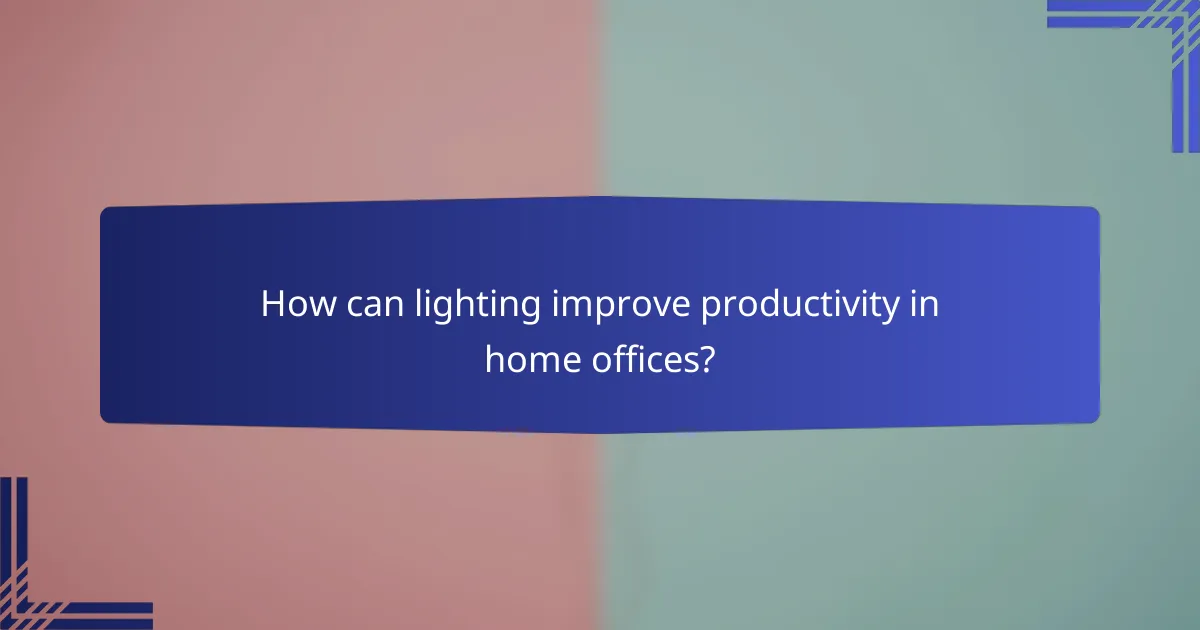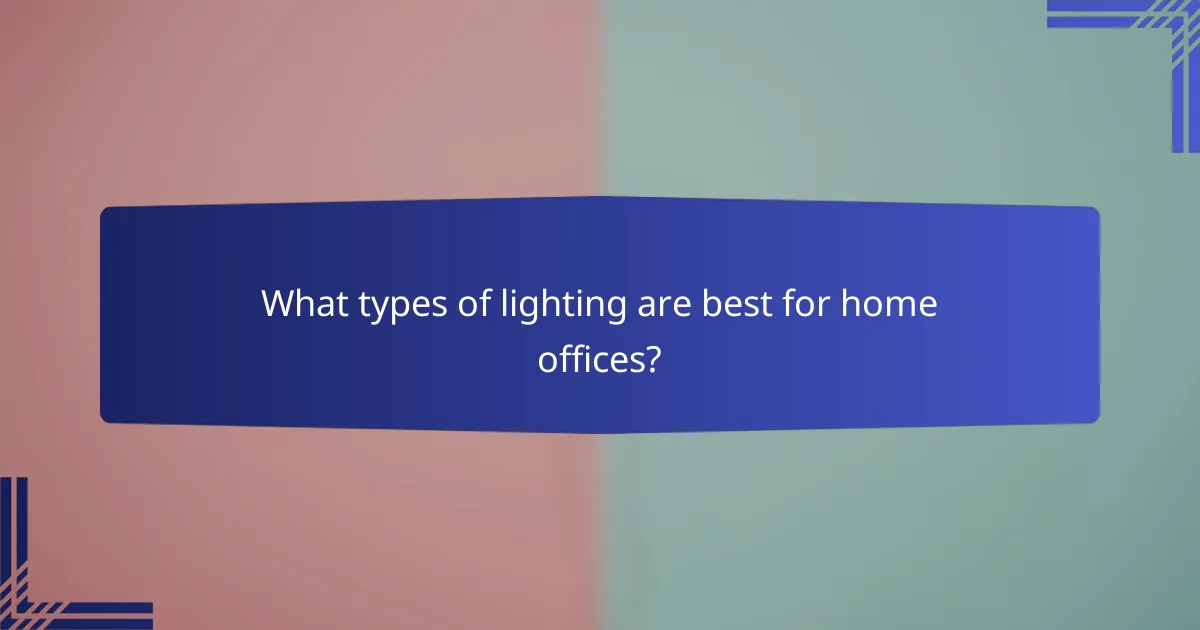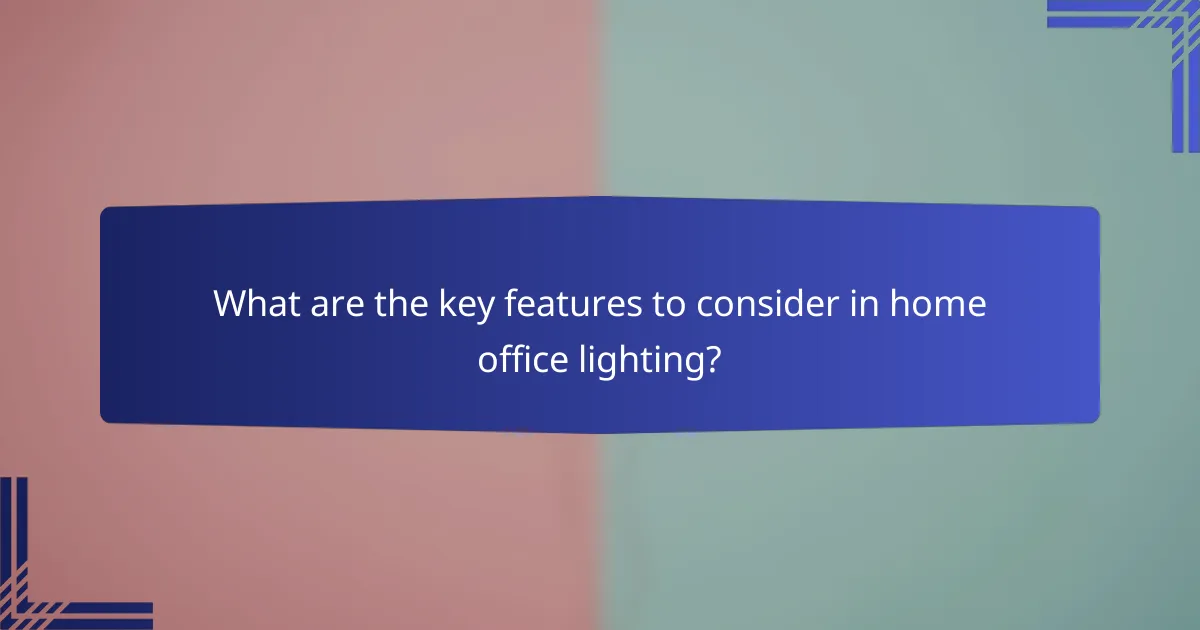Effective lighting solutions are essential for creating a productive and comfortable home office environment. By incorporating a mix of task, ambient, and accent lighting, you can reduce eye strain and maintain focus throughout the day. Prioritizing adjustable and energy-efficient options will enhance your workspace experience, making it both functional and inviting.

How can lighting improve productivity in home offices?
Lighting can significantly enhance productivity in home offices by reducing eye strain and creating a comfortable work environment. Properly designed lighting solutions can help maintain focus and energy levels throughout the day.
Task lighting benefits
Task lighting is essential for specific activities such as reading, writing, or using a computer. It provides direct illumination to work areas, reducing shadows and glare, which can lead to fatigue. Consider using adjustable desk lamps or under-shelf lighting to ensure adequate brightness where it’s needed most.
When selecting task lighting, aim for a brightness level of around 300 to 500 lumens for focused tasks. This range helps create a clear workspace without overwhelming the senses.
Ambient lighting effects
Ambient lighting sets the overall mood and tone of the home office. It should be soft and diffuse, allowing for a comfortable atmosphere that promotes relaxation and concentration. Ceiling fixtures, floor lamps, or wall sconces can be effective sources of ambient light.
To achieve a balanced lighting scheme, combine ambient lighting with task lighting. This layered approach ensures that the space is well-lit without harsh contrasts that can distract from work.
Color temperature impact
Color temperature, measured in Kelvin (K), affects how we perceive light and can influence productivity. Warmer tones (around 2700K to 3000K) create a cozy environment, while cooler tones (4000K to 5000K) promote alertness and focus. For home offices, a cooler color temperature is often recommended during work hours.
Consider using adjustable LED bulbs that allow you to change the color temperature based on the time of day. This flexibility can help align your lighting with your natural circadian rhythms, enhancing productivity and comfort throughout the day.

What types of lighting are best for home offices?
The best lighting for home offices includes a combination of task, ambient, and accent lighting to enhance productivity and comfort. Prioritizing adjustable and energy-efficient options can significantly improve your workspace experience.
LED desk lamps
LED desk lamps are ideal for home offices due to their energy efficiency and long lifespan. They provide focused light that helps reduce eye strain during extended work hours.
When selecting an LED desk lamp, consider features like adjustable brightness and color temperature. A lamp with a color temperature of around 4000K to 5000K mimics natural daylight, promoting alertness and concentration.
Smart lighting solutions
Smart lighting solutions allow for customizable lighting settings that can adapt to your work habits. These systems can be controlled via smartphone apps or voice commands, enabling you to adjust brightness and color temperature easily.
Consider integrating smart bulbs or fixtures that can change colors throughout the day. For instance, warmer tones in the evening can help signal relaxation, while cooler tones during the day can enhance focus.
Floor lamps for versatility
Floor lamps offer flexibility in lighting arrangements, making them suitable for various office layouts. They can provide ambient light or serve as accent pieces to complement your desk lighting.
When choosing a floor lamp, look for models with adjustable heights and shades that direct light where you need it most. A lamp with a dimmer switch can also help you create the right atmosphere for different tasks.

What are the key features to consider in home office lighting?
Key features to consider in home office lighting include adjustability, energy efficiency, and design compatibility. These elements significantly impact productivity and comfort, ensuring that your workspace is well-lit and conducive to focus.
Adjustability and brightness
Adjustability in home office lighting allows you to customize the brightness according to the time of day and the tasks at hand. Look for fixtures with dimmable options or adjustable arms to direct light where it is needed most.
Consider using a combination of ambient, task, and accent lighting to create a balanced environment. For example, a desk lamp with adjustable brightness can enhance focus during detailed work, while softer ambient lighting can reduce eye strain during longer hours.
Energy efficiency ratings
Energy efficiency ratings are crucial for reducing electricity costs and minimizing environmental impact. Look for lighting solutions with high ratings, such as LED bulbs, which typically consume less energy and have a longer lifespan compared to traditional incandescent bulbs.
When selecting fixtures, check for Energy Star certification or similar labels, which indicate compliance with energy efficiency standards. This can lead to savings of up to 75% on lighting costs over time.
Design compatibility
Design compatibility ensures that your lighting fixtures complement the overall aesthetic of your home office. Choose styles that align with your decor, whether modern, traditional, or minimalist, to create a cohesive look.
Consider the size and scale of the fixtures in relation to your workspace. A large pendant light may overwhelm a small desk, while sleek, wall-mounted lights can save space and add a contemporary touch.

How does lighting affect comfort in a home office?
Lighting significantly impacts comfort in a home office by influencing visibility, reducing fatigue, and enhancing the overall work environment. Proper lighting can create a more inviting space that promotes productivity and well-being.
Reducing eye strain
Good lighting is essential for reducing eye strain, which can occur from prolonged exposure to inadequate or harsh lighting. Natural light is often the best option; however, if that’s not available, consider using adjustable LED lights that mimic daylight.
Position your desk near windows if possible, and use task lighting to illuminate specific areas without causing glare. Aim for a brightness level of around 300 to 500 lux for comfortable reading and writing.
Creating a calming atmosphere
The right lighting can create a calming atmosphere in your home office, which is crucial for maintaining focus and reducing stress. Soft, warm light tones are generally more soothing than harsh, cool lights.
Incorporate dimmable lights or smart bulbs that allow you to adjust brightness and color temperature according to the time of day. This flexibility can help you transition from a bright, alert environment during work hours to a softer, more relaxed setting during breaks.
Influencing mood and focus
Lighting plays a vital role in influencing mood and focus, affecting how you feel while working. Bright, well-lit spaces can enhance alertness and concentration, while dim lighting may lead to drowsiness.
Consider using a combination of ambient, task, and accent lighting to create a balanced environment. For example, a well-lit desk area combined with softer background lighting can help maintain energy levels throughout the day.

What are the best lighting brands for home offices?
Some of the best lighting brands for home offices include IKEA and Philips Hue, known for their practical designs and smart technology. These brands offer a range of solutions that enhance productivity and comfort in a workspace.
IKEA lighting solutions
IKEA provides a variety of affordable lighting options suitable for home offices, focusing on functionality and style. Their desk lamps, floor lamps, and ceiling lights are designed to create a well-lit environment that minimizes eye strain.
When selecting IKEA lighting, consider adjustable features that allow you to direct light where it’s needed most. Popular models include the RANARP and HEKTAR series, which offer both task and ambient lighting.
Philips Hue smart lights
Philips Hue smart lights are ideal for those looking to integrate technology into their home office. These lights can be controlled via smartphone or voice commands, allowing for customizable brightness and color settings to match your mood or task.
With Philips Hue, you can set schedules and routines to automate your lighting, enhancing productivity throughout the day. Additionally, the ability to sync lights with your computer or music can create an engaging work atmosphere.
